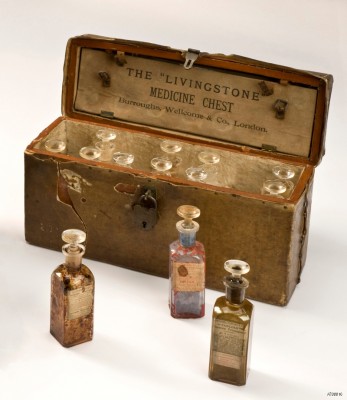When thinking about threats to the collection it is easy to think about fires, floods and theft. However, hungry little creatures can be just as devastating for our objects.

Don’t judge them by their size, small insect pests are actually one of the ten primary agents of deterioration that can cause irreversible damage to objects in museum collections.
As a Collections Care Conservator at the Science Museum stores in Blythe House, a fascinating part of my job is keeping these insects at bay.
In the past, museum collections with materials vulnerable to pests – such as textiles, wood, paper, and feathers – would fumigate their collections with a variety of pesticides. That would stop insects from attacking the collections, but unfortunately would also be extremely harmful to humans.
Nowadays, a crucial part of pest management is monitoring. It is essential to do regular checks of the stores and have a general idea of the insect populations. We must spot any areas of concern and stop the pests before it’s too late.
In order to do this, we place many insect traps throughout our stores. We use two types of insect traps: sticky traps, which insects get stuck to as they pass; and pheromone traps that attract and trick male moths looking for a nice smelling mate. You might have seen some of these traps around museums.
Identifying these little creatures can be quite fun, yet often challenging, as most of them are very small and often get destroyed in the traps themselves.
How do they get destroyed? (Turn away now insect lovers) Well, some poor creatures simply pull themselves apart as they walk through the traps, while others are found snacking on the unlucky guy stuck next to them. Often, we can only see half the insect, or a mass of various insects and arachnids together, which adds to the challenge of identifying them.

Even though adult insects are dangerous because they can reproduce, they don’t often eat our collection. It is their larvae that are more damaging; their ravenous hunger can be extremely destructive.
Whilst many insects aren’t directly harmful to our collections, they do tell us important information about environmental conditions in our stores. If we know, for example, that a specific insect thrives in particularly humid conditions, we can make assessments about those areas of the stores. We can also see which areas of the building are particularly easy for insects to enter.
Of course, it is impossible to prevent all insects from entering our stores. Our aim is to provide conditions that are not welcoming to pests: storage areas are kept at lower temperatures to stop insects thriving, and good hygiene and housekeeping are also crucial, as insects love messy, dark and undisturbed areas.
It is worth remembering that while pests can be a danger to our collections, there’s a lot of information we can learn from them too.
To meet some usual pest suspects, visit this website designed by Birmingham Museums and Art Galleries.
Fabiana Portoni is a Collections Care Conservator at the Science Museum.